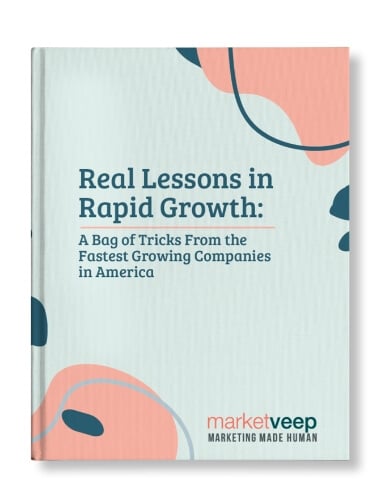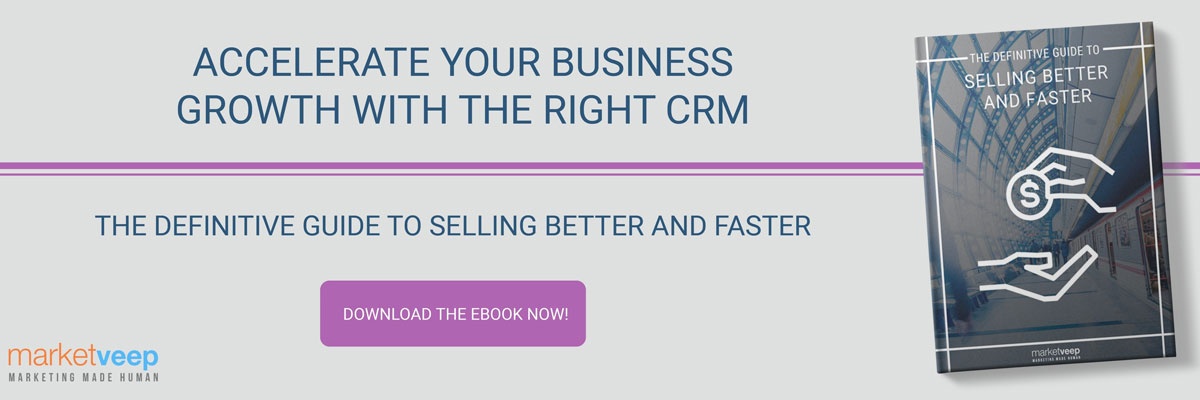7 Easy Tips for Improving Your Lead Conversion Process


By Market Veep
Converting leads into customers is perhaps the most important part of the inbound methodology.
It’s the stage where someone provides you with their information in exchange for a service you’ve offered them. This exchange of information will kickstart what you hope will become a long-lasting business relationship.
With the right tools, you can make sure that your lead conversion process is just the first step in a mutually beneficial relationship between buyer and seller. Here's you can make it happen for your company.



1) Ask the Right Questions
The first step in generating, and then converting good leads is to ask the right questions. If your questions are too broad, you may generate a lot of leads, but the percentage of those that are valuable, qualified leads will be far less than you want. If you ask too many questions, your visitors may ignore you entirely. The key is knowing what questions to ask and how many to ask in order to find and convert valuable leads.
You’ll be asking your leads questions in multiple places, such as in sales calls. But typically, you’ll ask your first question when the lead is ready to convert on a form or a landing page.
You have a number of options to choose from when deciding what questions to use on your landing page. The trick is knowing which ones — usually 2-4 choice questions are best—to use in order to attract and segment the best leads. Some of your options are:
-
Name (first and last)
-
Contact information (usually an email address or phone number)
-
Demographic data (age, gender, etc.)
-
Area of employment (job title, industry)
-
Geographic data (where do they live?)
-
Challenge (what do they need help with?)
-
Buyer persona
There’s more variety than this, of course, but remember, when it comes to finding good leads, you want your questions to be as simple as possible, but specific enough to help you segment the leads into buyer personas that will make it easier for you to pursue them further.
For example, if you’re a local business, then you’ll want your lead conversion process to focus on the people who live near you, so asking for a general location will help you segment your leads geographically, ultimately helping you better follow up with them later.
2) Choose Quality Over Quantity
Asking the right questions is the first step in ensuring you convert quality leads. While it can be tempting to amass as many leads as possible, you’ll be better off with a smaller, but more engaged, population of leads.
This doesn’t have to take the form of a practical action, but rather, should reflect a mindset you adopt as you continue to develop your lead conversion process.
Don’t be afraid of letting a lead go if you don’t think your solutions are a good fit for their problems. Time is a valuable commodity for you and your leads, so work with people and help them find a solution that meets their needs.
3) Take Advantage of Lead Scoring
Lead scoring can be a difficult concept to pin down, so take advantage of HubSpot’s helpful definition to get you started. They say that “lead scoring is a methodology used to rank prospects against a scale that represents the perceived value each lead represents to the organization.”
Some key benefits of using lead scoring include:
-
More effective marketing efforts
-
More effective sales efforts
-
Stronger profits
-
Better return-on-investment (ROI)
With that in mind, you can see how this ties into the mentality of “quality over quantity.” Where one is a mentality, the other is a practical tool you can employ in your lead conversion process that'll ensure your leads are valuable and of the highest quality.
When you set up a good lead scoring system, all the information a lead gives you on a form will be scored and assessed so you can get a snapshot of where a lead ranks on the scale you designed. This way, you can know who to follow up with first and have more data to use in your pursuit of successful lead conversions.
4) Use Customer Preferred Communication Channels
This is a simple step, but one that can go a long way towards improving your lead conversion process. When you ask a lead how they prefer to be contacted (email, cell phone, etc.), and then follow up via their preferred method, you show them that you’re willing to listen and meet them where they’re at. When first impressions are always important in establishing strong, lasting relationships, this can be a great strategy to utilize.
5) Diagnose the Problem
When you’re following up with a lead, that person should already be in the awareness stage of their buyer’s journey, and thus aware of a problem that they want to be solved. If they’ve given you their information — converting them into a lead — then they’re interested in hearing what kind of solution you can provide them with.
However, you still need to diagnose their problem. If you assume they’re looking for one solution when they’re really looking for another, then your communication will quickly break down and lead to confusion at best and frustration at worst. Listen to the lead, ask them questions about their problem, and then be explicit in your diagnosis of that problem. Again, your buyer personas will be a great asset here, as they’ll allow you to send the most relevant kinds of content to the people who will find the most value in it.
6) Highlight Testimonials
After that first contact has been made, and you’ve successfully offered a solution, the sales process can begin. Don’t be too aggressive though. You want to let your brand and products speak for themselves. When you highlight how well others have received your products or services, you implicitly advertise your trustworthiness without needing to actually pitch anything.
You can utilize testimonials at every stage of the inbound methodology, as it’s a great tool to attract visitors, nurture leads, and delight customers. Testimonials are some of the most effective tools at attracting potential customers and converting leads. According to Nielsen Research, 70% of people will trust a recommendation, even if they don’t know the person who provided the recommendation.
If you have a satisfied customer, send them a survey asking for a simple review of the services you provided. The more of these you can gather, the more effective your lead conversion process will be at converting leads into customers.
7) Always Follow Up
This one should be obvious, but you’d be surprised how often it can be overlooked. Following up with a lead is arguably the single most important step you can take when trying to secure a conversion. Once someone offers you their information, follow up with them as soon as possible.
The quicker you can make contact, the quicker you can diagnose their problem, propose a solution, and ultimately build a relationship that should lead to a successful conversion. Following up doesn’t always have to be directly about selling either.
One of the best ways to make sure you never miss a chance to follow-up with someone is to take advantage of a workflow. According to HubSpot’s definition, “a workflow is an automated set of marketing and/or sales actions that execute based on a starting condition.” That starting condition, in most cases, is when a visitor becomes a lead, and thus begins their buyer’s journey in earnest.
With workflows, you can automate your lead conversion process so a lead is reached out to desired intervals, and depending on the kind of automation you use, it’s even possible to use branching logic in order to curate the way a workflow communicates with a contact based on how they’ve previously interacted with your website and content.
Following up with a lead can be as simple as thanking them for sharing their information or sending them a blog post you think they’d find valuable. There’s no golden rule here, but consistency, as always, is key.
The more familiar a lead is with you and your service, the more effective your lead conversion process will be. And the more effective your lead conversion process is, the more likely your target audience will be to become an advocate for your brand and its services.
What Is Lead Conversion?
Lead conversion is a sales and marketing term that describes the art of convincing potential customers (leads) to become actual paying customers. Strong lead conversion strategies acknowledge that converting leads to customers takes time, as many prospects pass through several key stages along their road to a purchase decision.
- General leads are people who could potentially be customers based on their needs, interests, or other factors.
- General leads become Marketing Qualified Leads (MQLs) once they’ve indicated some interest in your company. But while they’ve may have signed up for your newsletter or filled out a contact form, they’re still not quite ready to buy.
- MQLs make the leap to Sales Qualified Leads (SQLs) when they enter the decision-making stage. SQLs are basically paying customers begging to happen and are generally ready to make contact with your sales team.
- The SQL’s conversion into a paying customer is officially complete once they make their first official purchase.
Lead Conversion Best Practices
If there’s one thing worth mastering as a salesperson or marketer, it’s how to increase lead conversion rates. Not only can developing efficient lead conversion methods put you on the fast track to success, but it can also make your work life a lot easier. On your end, the lead conversion process will often boil down to several key strategies:
Knowing your customer. Developing a strong understanding of your buyer personas will help you hone in the most promising prospects and create content that attracts the right audience.
Nurturing your leads. Make it as easy as possible for MQLs to find out everything they need to know with automated email campaigns, excellent content, and clear CTAs.
Timing is everything. Lead scoring can go a long way toward ensuring that you reach out to SQLs at just the right time.
Lead Conversion Metrics
Tracking the right metrics is one of the most efficient ways to measure how well your lead conversion strategies are working. Consider utilizing a tool like Google Analytics or HubSpot’s Built-in Marketing Analytics dashboard to glean insights from the following KPIs:
Website Traffic: How many general leads is your site pulling in?
Lead Sources: Which channels are helping you generate leads the most effectively?
Landing Page Conversion Rate: How many general leads are taking the actions required to become MQLs?
Lead-to-Sale Conversion Rate: What’s your overall success rate of converting leads to customers?
Time to Conversion: How long does converting leads into customers take on average?
Customer Acquisition Cost (CAC): How much does it cost to convert a new customer on average?
These are just a few of the many conversion metrics that can give you valuable insights into your conversion strategies. Don’t be afraid to experiment and find the right collection of metrics to keep you on track toward your goals.
Get The Latest From
Market Veep
RELATED ARTICLES

Master Sales Funnel Strategies: Tofu Mofu Bofu!
Between SEO, SEM, and SERPS, we’re always finding clever ways to break down concepts into four...

Why B2B Demand Generation Strategies Work
The sparkly, PR rep cousin of lead generation, this approach is all about growing your audience by...

Key Marketing Strategies for Robotics Manufacturers
In fact, experts project that the U.S. Robotics market is on track to pull in $7.85 billion in 2024...

Get Growing!
Download our eBook and get advice from 8 CEOs of Inc. 5000 companies in their own words.

GREAT MARKETING PARTNER
Market Veep is a great firm that handles all of our marketing efforts. This is the second time that I have used the firm. I highly recommend Market Veep!

Cres F.

EXCEPTIONAL EXPERIENCE
Market Veep's Onboarding Experts in Inbound Marketing are an absolute game-changer! From the get-go, their approach was top-notch. Market Veep's team has undoubtedly set the bar high for excellence in inbound marketing. Five stars aren't enough to commend their outstanding service!

Matthew W.

BEST PARTNER EVER!
As a growing business, setting up our first-ever HubSpot account was a crucial step towards enhancing our marketing and customer management strategies. From the moment we contacted MarketVeep, their team demonstrated professionalism, expertise, and a genuine desire to help us succeed. Overall, our experience with MarketVeep was exceptional, and we couldn't be happier with the results. Thanks to their guidance, we are now utilizing HubSpot to its fullest potential, streamlining our marketing efforts, and nurturing leads more effectively.

Jean M.

SET UP FOR SUCCESS!
We had an exceptional experience with Market Veep! Their team is professional, super organized, and friendly, and I truly enjoyed working with them. They executed on time and made the process super easy with their organization and documentation. In addition, they provided additional guidance and answered my many questions as I was new to HubSpot, and provided documentation resources for future use. We're now set up to leverage all that HubSpot marketing has to offer, and we couldn't have done it without Market Veep's expertise.

Bailey G.

OUTSTANDING WORK
There aren't enough words to describe the outstanding, professional work MarketVeep has provided to our company. From start to finish, the website design/development team at MarketVeep assigned to our project was extremely knowledgable, respectful, efficient and timely. The results went above and beyond our expectations and we could not be more thrilled with the improvements to the user experience on our website! Bravo MarketVeep, we'll absolutely be back with more projects!

Nadine B.

5 STARS FOR MARKET VEEP!
We had a fantastic experience with Market Veep! Their expert team seamlessly guided us through implementing HubSpot and provided comprehensive training across Sales, Service, and Marketing Hubs. Their knowledge and support significantly enhanced our workflow and overall efficiency. Highly recommend Market Veep for top-notch HubSpot solutions!

Anneke C.








